Spindle checkpoint-independent inhibition of mitotic chromosome segregation by Drosophila Mps1
- PMID: 22553353
- PMCID: PMC3374747
- DOI: 10.1091/mbc.E12-02-0117
Spindle checkpoint-independent inhibition of mitotic chromosome segregation by Drosophila Mps1
Abstract
Monopolar spindle 1 (Mps1) is essential for the spindle assembly checkpoint (SAC), which prevents anaphase onset in the presence of misaligned chromosomes. Moreover, Mps1 kinase contributes in a SAC-independent manner to the correction of erroneous initial attachments of chromosomes to the spindle. Our characterization of the Drosophila homologue reveals yet another SAC-independent role. As in yeast, modest overexpression of Drosophila Mps1 is sufficient to delay progression through mitosis during metaphase, even though chromosome congression and metaphase alignment do not appear to be affected. This delay in metaphase depends on the SAC component Mad2. Although Mps1 overexpression in mad2 mutants no longer causes a metaphase delay, it perturbs anaphase. Sister kinetochores barely move apart toward spindle poles. However, kinetochore movements can be restored experimentally by separase-independent resolution of sister chromatid cohesion. We propose therefore that Mps1 inhibits sister chromatid separation in a SAC-independent manner. Moreover, we report unexpected results concerning the requirement of Mps1 dimerization and kinase activity for its kinetochore localization in Drosophila. These findings further expand Mps1's significance for faithful mitotic chromosome segregation and emphasize the importance of its careful regulation.
Figures

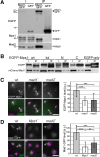
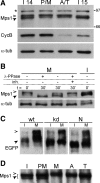
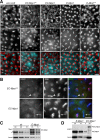
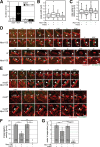
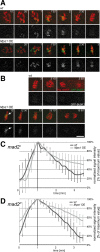
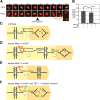
Similar articles
-
Mad2-independent spindle assembly checkpoint activation and controlled metaphase-anaphase transition in Drosophila S2 cells.Mol Biol Cell. 2007 Mar;18(3):850-63. doi: 10.1091/mbc.e06-07-0587. Epub 2006 Dec 20. Mol Biol Cell. 2007. PMID: 17182852 Free PMC article.
-
Conserved signalling functions for Mps1, Mad1 and Mad2 in the Cryptococcus neoformans spindle checkpoint.PLoS Genet. 2024 Jun 3;20(6):e1011302. doi: 10.1371/journal.pgen.1011302. eCollection 2024 Jun. PLoS Genet. 2024. PMID: 38829899 Free PMC article.
-
Mps1-mediated release of Mad1 from nuclear pores ensures the fidelity of chromosome segregation.J Cell Biol. 2020 Mar 2;219(3):e201906039. doi: 10.1083/jcb.201906039. J Cell Biol. 2020. PMID: 31913420 Free PMC article.
-
Mps1 kinase functions in mitotic spindle assembly and error correction.Trends Biochem Sci. 2025 May;50(5):438-453. doi: 10.1016/j.tibs.2025.02.005. Epub 2025 Mar 12. Trends Biochem Sci. 2025. PMID: 40082122 Review.
-
Orchestration of the spindle assembly checkpoint by CDK1-cyclin B1.FEBS Lett. 2019 Oct;593(20):2889-2907. doi: 10.1002/1873-3468.13591. Epub 2019 Sep 13. FEBS Lett. 2019. PMID: 31469407 Review.
Cited by
-
Teflon promotes chromosomal recruitment of homolog conjunction proteins during Drosophila male meiosis.PLoS Genet. 2022 Oct 17;18(10):e1010469. doi: 10.1371/journal.pgen.1010469. eCollection 2022 Oct. PLoS Genet. 2022. PMID: 36251690 Free PMC article.
-
Absence of the Spindle Assembly Checkpoint Restores Mitotic Fidelity upon Loss of Sister Chromatid Cohesion.Curr Biol. 2018 Sep 10;28(17):2837-2844.e3. doi: 10.1016/j.cub.2018.06.062. Epub 2018 Aug 16. Curr Biol. 2018. PMID: 30122528 Free PMC article.
-
Dynamics and control of sister kinetochore behavior during the meiotic divisions in Drosophila spermatocytes.PLoS Genet. 2018 May 7;14(5):e1007372. doi: 10.1371/journal.pgen.1007372. eCollection 2018 May. PLoS Genet. 2018. PMID: 29734336 Free PMC article.
-
Mad1 influences interphase nucleoplasm organization and chromatin regulation in Drosophila.Open Biol. 2018 Oct 17;8(10):180166. doi: 10.1098/rsob.180166. Open Biol. 2018. PMID: 30333236 Free PMC article.
-
A maternal effect rough deal mutation suggests that multiple pathways regulate Drosophila RZZ kinetochore recruitment.J Cell Sci. 2015 Mar 15;128(6):1204-16. doi: 10.1242/jcs.165712. Epub 2015 Jan 22. J Cell Sci. 2015. PMID: 25616898 Free PMC article.
References
-
- Abrieu A, Magnaghi-Jaulin L, Kahana JA, Peter M, Castro A, Vigneron S, Lorca T, Cleveland DW, Labbe JC. Mps1 is a kinetochore-associated kinase essential for the vertebrate mitotic checkpoint. Cell. 2001;106:83–93. - PubMed
-
- Brand AH, Perrimon N. Targeted gene expression as a means of altering cell fates and generating dominant phenotypes. Development. 1993;118:401–415. - PubMed
-
- Buffin E, Emre D, Karess RE. Flies without a spindle checkpoint. Nat Cell Biol. 2007;9:565–572. - PubMed
-
- Buffin E, Lefebvre C, Huang J, Gagou ME, Karess RE. Recruitment of Mad2 to the kinetochore requires the Rod/Zw10 complex. Curr Biol. 2005;15:856–861. - PubMed
Publication types
MeSH terms
Substances
LinkOut - more resources
Full Text Sources
Molecular Biology Databases
Research Materials

